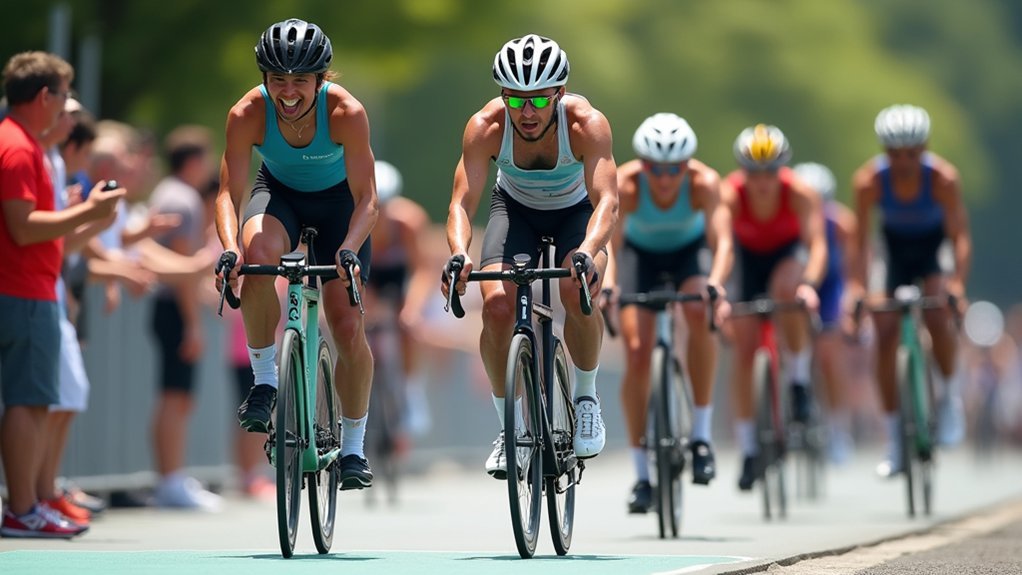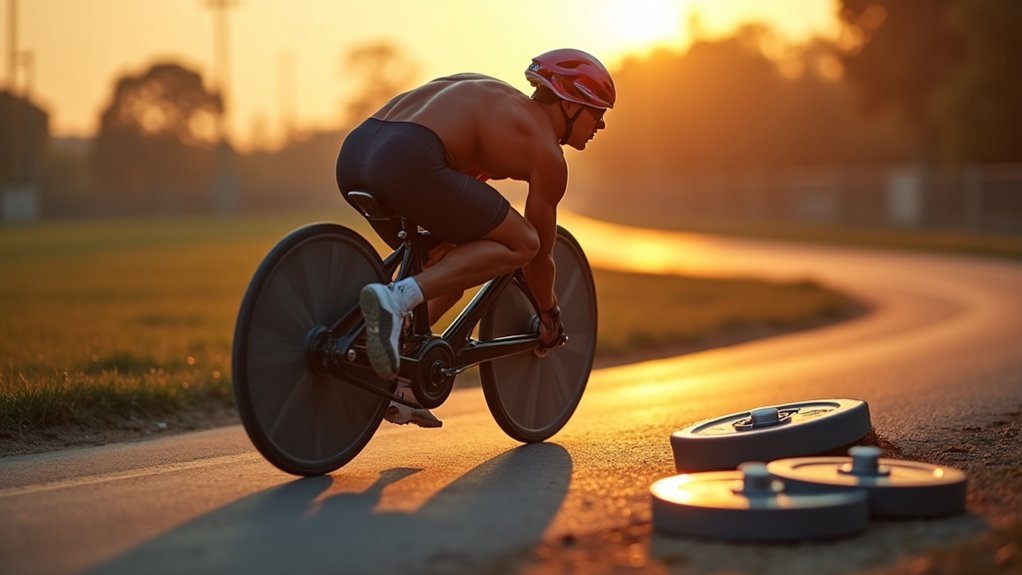The 7 best hand-cycling workouts for Paralympic success include upper body interval training with explosive bursts, heavy weight training with low repetitions, balance exercises for stability, long-distance endurance sessions, race simulation workouts, hill training for power building, and equipment optimization. You’ll need to commit to six weekly sessions alternating between intense cycling, weights, and recovery. Proper nutrition timing and rest days are equally essential. The complete training approach will transform your Paralympic potential.
7 Best Hand-Cycling Workouts For Paralympic Success

While many athletes focus solely on endurance, truly successful Paralympic hand-cyclists commit to a thorough training regimen.
You’ll need to dedicate yourself to training six times a week, alternating between intense cycling sessions, weight training, and recovery through physiotherapy.
Develop explosive strength by focusing on low-repetition, heavy-weight exercises that build the quick acceleration needed in competitive situations.
Explosive power from heavy-weight training creates the acceleration that separates champions from competitors.
This approach helps you maintain speed throughout races and respond effectively when tactics change.
Don’t overlook balance training, which is essential for sprint performance and race readiness.
Incorporate both gym-based conditioning and home exercises that enhance coordination and cycling efficiency.
Consider regular equipment modifications like electronic gear shifters and custom components that can be adjusted to match specific race conditions, giving you a competitive edge.
Upper Body Interval Training: Developing Sprint Power
You’ll maximize your sprint power by incorporating high-intensity pedaling bursts followed by strategic recovery periods throughout your hand-cycling training.
Building explosive strength requires focused weight training with heavy loads and low repetitions to activate fast-twitch muscle fibers essential for competitive sprinting.
Commit to six weekly sessions that combine these interval workouts with balance and coordination exercises to enhance power transfer during vital sprint phases of Paralympic competition.
Sprint Power Fundamentals
Since hand-cycling success hinges on explosive upper body strength, developing sprint power requires strategic interval training that targets specific muscle groups.
You’ll need to incorporate short bursts of maximum effort followed by recovery periods to boost your peak power output and sprint endurance.
Focus on heavy weight training with low repetitions to enhance the muscle fibers responsible for explosive power.
This approach directly translates to improved acceleration during race attacks.
Don’t overlook balance training, which is essential for maintaining control during high-intensity sprints.
Track your progress through regular timed trials to measure improvements and adjust your training accordingly.
This data-driven approach guarantees you’re making superior gains as you prepare for Paralympic competition, allowing you to fine-tune your sprint power development for when it matters most.
Explosive Strength Development
Power translates directly to performance in hand-cycling sprints, making explosive strength development the cornerstone of any Paralympic training program. You’ll need to focus on low-repetition, heavy-weight exercises that target your upper body’s primary muscle groups.
Incorporate interval training to simulate race conditions, helping you develop both the endurance and explosive strength needed for competitive scenarios. Balance training is equally essential as it improves your stability during high-speed cycling.
| Exercise Type | Benefits for Hand Cycling |
|---|---|
| Heavy Bench Press | Primary chest power development |
| Weighted Pull-ups | Back and arm explosiveness |
| Interval Sprints | Race-specific power endurance |
| Suspension Training | Core stability and coordination |
| Balance Drills | Improved control at high speeds |
These targeted workouts will transform your sprint capabilities, giving you the explosive power needed for Paralympic success.
Heavy Weight Training for Explosive Strength

When Paralympic hand-cyclists aim for gold, heavy weight training becomes an indispensable component of their preparation.
You’ll need to focus on low repetitions with heavy weights to maximize explosive strength and power transfer during races.
Incorporate fundamental exercises like squats, deadlifts, and bench presses to build the all-encompassing body strength that supports your upper body performance.
Add Olympic lifts to develop fast-twitch muscle fibers essential for sprinting and acceleration.
Commit to twice-weekly intensive sessions of about five hours each to maintain peak condition and prevent muscle fatigue during competition.
Don’t overlook balance training within your weight workouts—it guarantees the stability and coordination necessary for efficient power transfer when you’re pushing for the finish line.
This all-encompassing approach will notably enhance your hand-cycling performance.
Balance and Coordination Exercises for Hand Cyclists
Although often overlooked in training regimens, balance and coordination exercises form the cornerstone of elite hand-cycling performance. You’ll need these skills to maintain control during sprints and respond effectively to sudden race attacks.
Incorporate suspension training into your routine to develop upper body strength while improving your ability to maneuver your hand cycle with precision.
Balance training doesn’t just happen in the gym—home workouts featuring coordination drills are essential complements to traditional strength sessions.
For maximum benefit, combine low-repetition, heavy-weight exercises with balance drills to optimize functional strength and muscle engagement. This integration enhances explosiveness during critical race moments.
Endurance Building Through Long-Distance Sessions

Three key components determine success in Paralympic hand cycling, with endurance standing as perhaps the most critical foundation. You’ll need significant stamina to cross that finish line strong, which comes through dedicated long-distance training sessions of 20-60 miles.
Incorporate these sessions weekly, gradually increasing your distance while maintaining moderate intensity. You’ll simulate race conditions by including varied terrains that challenge your body’s fatigue management systems.
| Distance | Frequency | Benefits |
|---|---|---|
| 20-30 miles | Weekly | Basic endurance foundation |
| 30-45 miles | Bi-weekly | Improved cardiovascular capacity |
| 45-60 miles | Monthly | Elite endurance like cyclists around the world |
Don’t forget to develop proper nutrition and hydration strategies to fuel these longer rides, ensuring peak energy levels throughout your training and faster recovery afterward.
Recovery Techniques for Paralympic Athletes
After completing those grueling long-distance rides, your body requires strategic recovery protocols to maintain peak performance. Unlike cycling’s reigning able-bodied athletes, your recovery needs are completely different and require specialized attention.
Incorporate active recovery sessions and foam rolling to reduce muscle soreness and boost circulation. Schedule regular rest days—they’re not optional but essential for your body to repair and adapt.
Don’t overlook physiotherapy treatments tailored to address specific strains from hand cycling. Nutrition timing matters greatly—consume protein and carbohydrates within 30 minutes post-workout.
Try contrast baths (alternating hot and cold water) to reduce inflammation after intense sessions. These recovery techniques aren’t just supplementary—they’re fundamental components that will elevate your Paralympic hand cycling performance to elite levels.
Specialized Resistance Training for Hand Cycling
To build the explosive power you’ll need for hand-cycling success, incorporate an upper body power circuit that targets your shoulders, arms, and core muscle groups.
Your training should follow progressive resistance methods, gradually increasing weights while decreasing repetitions to maximize strength gains specific to hand cycling movements.
Balance this specialized training with your overall conditioning program, ensuring you’re dedicating about five hours weekly to resistance work that directly translates to improved performance on your hand cycle.
Upper Body Power Circuit
Mastering hand-cycling demands exceptional upper body strength, particularly when competing at Paralympic levels. Your power circuit should focus on explosive strength using heavy weights with low repetitions to build the muscle power needed for sprints and climbs.
Incorporate compound movements like bench presses, rows, and shoulder presses to enhance your overall upper body strength.
Don’t neglect balance training, which develops the stability and coordination essential for effective power transfer during cycling.
At home, you can complement gym sessions with resistance bands and suspension training to improve muscle endurance and functional strength.
Remember to regularly assess and adjust your workout routine to guarantee continued progression.
This systematic approach to power development will directly translate to improved race performance and help you reach your Paralympic potential.
Progressive Resistance Methods
Progressive resistance training forms the backbone of any serious Paralympic hand-cycling program. You’ll need to gradually increase both weight and intensity during workouts to develop the upper body strength required for competitive racing.
Focus on low-repetition, heavy-weight exercises to build explosive strength—this directly enhances your sprinting capabilities.
When training at home, incorporate resistance bands to improve coordination and stability, essential elements for maintaining balance during intense races.
Don’t overlook balance training as you progress your resistance methods. This prepares you for sudden directional changes and pace variations during competition.
For best results, regularly adjust your equipment with custom gear ratios and electronic shifters to complement your strength gains, maximizing power output and efficiency on the course.
Core Strengthening Routines for Better Stability
While hand cyclists focus primarily on upper body strength, your core serves as the critical foundation that transforms raw power into competitive advantage. A strong core enhances stability and power transfer during cycling, directly impacting your race performance.
The core: your hidden engine that transforms arm strength into racing dominance.
Incorporate these core-strengthening exercises into your routine:
- Planks and Russian twists to improve stability and rotational power
- Medicine ball throws for developing explosive strength needed during sprints
- Balance training with stability balls to enhance proprioception and coordination
- Low-repetition, high-weight exercises targeting core muscles for explosive power
- Suspension training at home to complement gym workouts and improve overall stability
These exercises won’t just improve your balance—they’ll enhance your responsiveness during critical race moments, giving you that competitive edge when it matters most.
Race Simulation Workouts for Mental Preparation
Race simulations provide you with critical mental strength for Paralympic competition through focused course visualization sessions that replicate actual race conditions.
You’ll strengthen your mental resilience by practicing pressure response training that deliberately introduces stress factors like time constraints or unexpected obstacles.
These targeted workouts help you develop the psychological fortitude needed to maintain focus when faced with the unique challenges of high-stakes Paralympic hand-cycling events.
Course Visualization Sessions
Beyond physical conditioning, successful Paralympic hand-cyclists rely on powerful mental preparation techniques to gain competitive advantages. Course visualization sessions enable you to mentally map your race before competition day, creating a mental blueprint of what you’ll experience.
- Mentally simulate the entire course, focusing on terrain changes, technical turns, and strategic sections where you’ll push or recover.
- Incorporate specific course landmarks to build familiarity and reduce race-day anxiety.
- Practice responding to potential challenges like weather changes or competitor moves.
- Visualize your ideal hand cycling mechanics, breathing patterns, and pacing strategy.
- Combine visualization with physical training, dedicating 10-15 minutes daily to mental rehearsal.
Regular visualization practice strengthens your mental resilience and focus, giving you confidence to execute your race plan under pressure—a critical edge in Paralympic competition.
Pressure Response Training
Since Paralympic competition demands peak performance under extreme pressure, incorporating race simulation workouts into your training regimen is essential for mental preparation. Structure these sessions to mirror actual race conditions by including timed sprints and carefully paced endurance segments that reflect competition intensity.
To maximize benefits, introduce unexpected challenges during workouts—sudden pace changes, simulated competitor surges, or technical course elements. This trains your body and mind to adapt quickly when facing similar situations during competition.
Pair these physical workouts with visualization techniques, mentally rehearsing successful race scenarios and problem-solving strategies. You’ll build the confidence needed to make split-second decisions under pressure.
Consistent pressure response training develops the mental resilience that often separates medalists from competitors—helping you perform at your best when it matters most.
Hill Training Strategies for Hand Cyclists
When tackling competitive hand-cycling courses, your ability to conquer hills efficiently can make the difference between podium placement and disappointment. Integrating structured hill workouts into your training regimen develops the explosive strength and endurance necessary for Paralympic success.
- Incorporate interval training on inclines—alternate between 30-second maximum efforts and 90-second recovery periods.
- Schedule weekly hill sprint sessions (6-8 repetitions) to build power while simulating race conditions.
- Maintain proper upper body positioning to maximize power transfer and prevent injury.
- Start with moderate gradients (3-5%) and progressively advance to steeper inclines (8-12%).
- Use technology to track your power output during climbs, ensuring consistent improvement.
As you master these hill training strategies, you’ll develop the climbing prowess that distinguishes elite Paralympic hand cyclists from their competitors.
Equipment Optimization for Peak Performance
While conquering hills represents a fundamental skill for Paralympic hand cyclists, your equipment setup ultimately determines how effectively you translate training efforts into competitive results.
Proper bike adjustments specific to course terrain are essential—particularly for flat surfaces like those in Rio de Janeiro.
You’ll gain significant advantages by installing an electronic gear shifter for quicker, more precise gear changes during competition.
Don’t overlook customizing your chain ring and cassette to match the expected course conditions.
Partner with a skilled mechanic who can fine-tune your hand cycle for peak acceleration and handling.
Regular maintenance of brakes and steering mechanisms guarantees both safety and performance reliability.
Most importantly, tailor all modifications to your unique strength profile, maximizing power output where you naturally excel.
Cross-Training Methods to Prevent Plateaus
Even the most dedicated hand-cycling training program can lead to performance plateaus if you don’t diversify your approach. Incorporating strategic cross-training routines will keep your body challenged and help you break through performance barriers while addressing muscular imbalances.
- Add weight training with heavy loads and low repetitions to boost explosive strength vital for sprinting.
- Integrate balance exercises to improve your sprint capacity and readiness for sudden race attacks.
- Include swimming or rowing sessions to enhance upper body strength while providing active recovery.
- Commit to regular physiotherapy and at-home coordination exercises to maintain overall conditioning.
- Schedule periodic bike mechanics adjustments, optimizing gear ratios and weight distribution for different race conditions.
Don’t wait until your performance stagnates—proactively cycle these cross-training methods into your weekly regimen for continuous Paralympic-level improvement.
Frequently Asked Questions
Is Hand Cycling a Paralympic Sport?
Yes, hand cycling is a Paralympic sport. It’s been part of the Paralympic Games since 2004. You’ll find athletes competing in various classifications based on their upper body functionality through time trials and road races.
How to Get Into Paralympic Cycling?
To get into Paralympic cycling, you’ll need to assess your eligibility classification, connect with local disability sports organizations, build upper body strength, participate in introductory events, and guarantee your hand cycle fits your specific needs.
Is Hand Cycling a Good Workout?
Yes, hand cycling is an excellent workout for you. It strengthens your upper body muscles, improves your cardiovascular health, and enhances coordination. You’ll build arm, shoulder, and core strength while boosting your endurance.
What Is C1 Cycling in Paralympics?
In Paralympics, C1 cycling classifies athletes with severe impairments affecting both arms and legs. You’ll see these competitors using hand cycles, as their disabilities greatly impact function compared to other para-cycling classifications.
In Summary
You’ve now got the training blueprint to compete at the highest paralympic level. By combining these hand-cycling workouts, you’ll develop the explosive power, endurance, and mental fortitude needed for gold medal performances. Don’t forget to personalize your approach—what works for one athlete won’t necessarily work for you. Keep pushing your limits, refining your techniques, and you’ll find yourself crossing that finish line faster than ever.





Leave a Reply